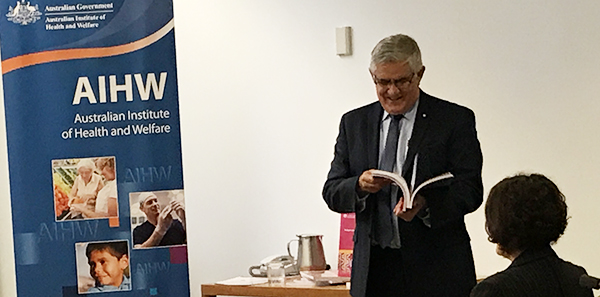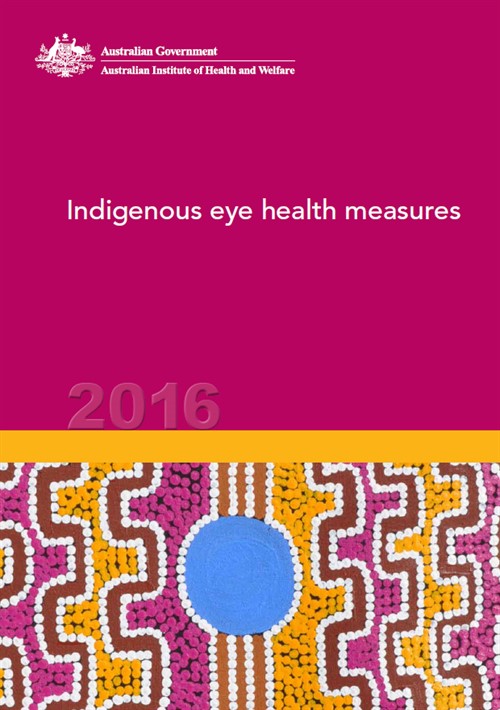1:30min

Minister for Indigenous Health Ken Wyatt launching the Indigenous reports Photo: Australian Institute of Health and Welfare
______________________________
By Helen Carter
Journalist
Optometry Australia helped advocate for the first national report on Indigenous eye health measures, launched by Minister for Indigenous Health Ken Wyatt.
The report was one of two new Australian Institute of Health and Welfare (AIHW) products launched by Minister Wyatt at Parliament House on 30 May.
Indigenous eye health measures 2016 reports on 22 newly-developed Indigenous eye health measures. It covers the prevalence of eye health conditions, diagnosis and treatment services for Aboriginal and Torres Strait Islander Australians, the eye health workforce and outreach services.
It examines differences between Indigenous and non-Indigenous Australians, and differences by factors including age, sex, remoteness, jurisdiction and Primary Health Network.
Optometry Australia national policy manager Skye Cappuccio said Vision 2020 Australia, of which Optometry Australia is an active member, had advocated for the establishment of these measures to support monitoring and oversight of Indigenous eye health. Optometry Australia was also a member of the advisory group that supported the AIHW in developing the report.
‘The measures are important to support ongoing monitoring of eye health among Aboriginal and Torres Strait Islander people and of the unacceptable gap in eye health between Indigenous and non-Indigenous Australians,’ she said.
‘Hopefully these 2016 measures will become a benchmark against which we can assess progress being made to close the gap for eye health.’
Findings include:
- Indigenous Australians suffer from vision impairment or blindness at three times the rate of non-indigenous Australians.
- In 2016 the prevalence of bilateral vision impairment for Indigenous Australians aged 40 years and older was 10.5 per cent, and the prevalence of bilateral blindness was 0.3 per cent, both affecting an estimated 18,300 Indigenous Australians aged 40 years and older.
- The three leading causes of vision impairment for older Indigenous adults were refractive error (63 per cent), cataract (20 per cent) and diabetic retinopathy (5.5 per cent.)
- Indigenous Australians who had an eye examination by an eye-care professional in the preceding 12 months rose from 13 per cent in 2005–2006 to 15 per cent in 2014–2015.
- The number of occasions of service for Indigenous patients under the Visiting Optometrists Scheme almost tripled between 2009–2010 and 2014–2015, rising from 6,975 to 18,890.
- In 2014–2015, 15 per cent of Indigenous Australians had an eye examination by an optometrist or ophthalmologist in the preceding 12 months compared with 20 per cent of non-Indigenous Australians.
- Indigenous Australians had a lower rate of hospitalisations for eye diseases and cataract surgery compared with non-Indigenous Australians but three times the rate for injuries to the eye.
- Repeated untreated trachoma infections are a cause of vision loss in some remote Indigenous communities, but the prevalence of active trachoma in children aged five to nine years in at-risk communities fell from 14 per cent in 2009 to 4.6 per cent in 2015.

Framework tool
The second item launched, the Aboriginal and Torres Strait Islander Health Performance Framework 2017 Report includes a suite of products and a data visualisation tool which give the latest information on how Aboriginal and Torres Strait Islander people are faring according to 68 performance measures.
A report card overview of each performance measure and options for displaying detailed, customisable charts are available. The data visualisation tool can be downloaded.
Information includes:
- In 2014–2015, 10 per cent of Indigenous children aged 0–14 years reported eye or sight problems, mainly hyperopia and myopia, an increase from seven per cent in 2008.
- Diabetes incidence, hospitalisations and deaths are more common among Indigenous Australians than other Australians and there are challenges in implementing strategies to achieve effective secondary prevention such as eye checks.
- Indigenous Australians experience higher rates of cataract, diabetic retinopathy and trachoma compared with non-Indigenous Australians.
- The Australian Government is providing $51 million up to 2019 to improve eye health in Indigenous Australians. State and territory governments are delivering Indigenous eye health programs.
Higher blindness rates in rural areas
Meanwhile, Australians living in regional and remote areas have marginally higher rates of blindness than those in major cities, a new report shows.
The Rural Health web report, released by the Australian Institute of Health and Welfare on 28 May, found that 0.5 per cent of people in major cities suffered partial or complete blindness compared with 0.9 per cent of those in inner regional areas and 0.8 per cent of people in outer regional or remote areas.
The authors said poorer health outcomes in rural and remote areas may be due to a range of factors, including disadvantage relating to education and employment opportunities, income and access to health services.
The information came from the institute’s report, Australia’s Health 2016.
Australia’s Health 2016 also found that overall 33.4 per cent of Indigenous Australians experienced eye disease and vision problems.
While 8.8 per cent of Indigenous people aged 14 years and younger experienced eye disease and vision problems, this jumped to 22 per cent aged 15 to 24 years, 27.4 per cent aged 25 to 34 years, 46.7 per cent aged 35 to 44 years, 87.2 per cent aged 45 to 54 years, and 92.4 per cent aged 55 years and older.